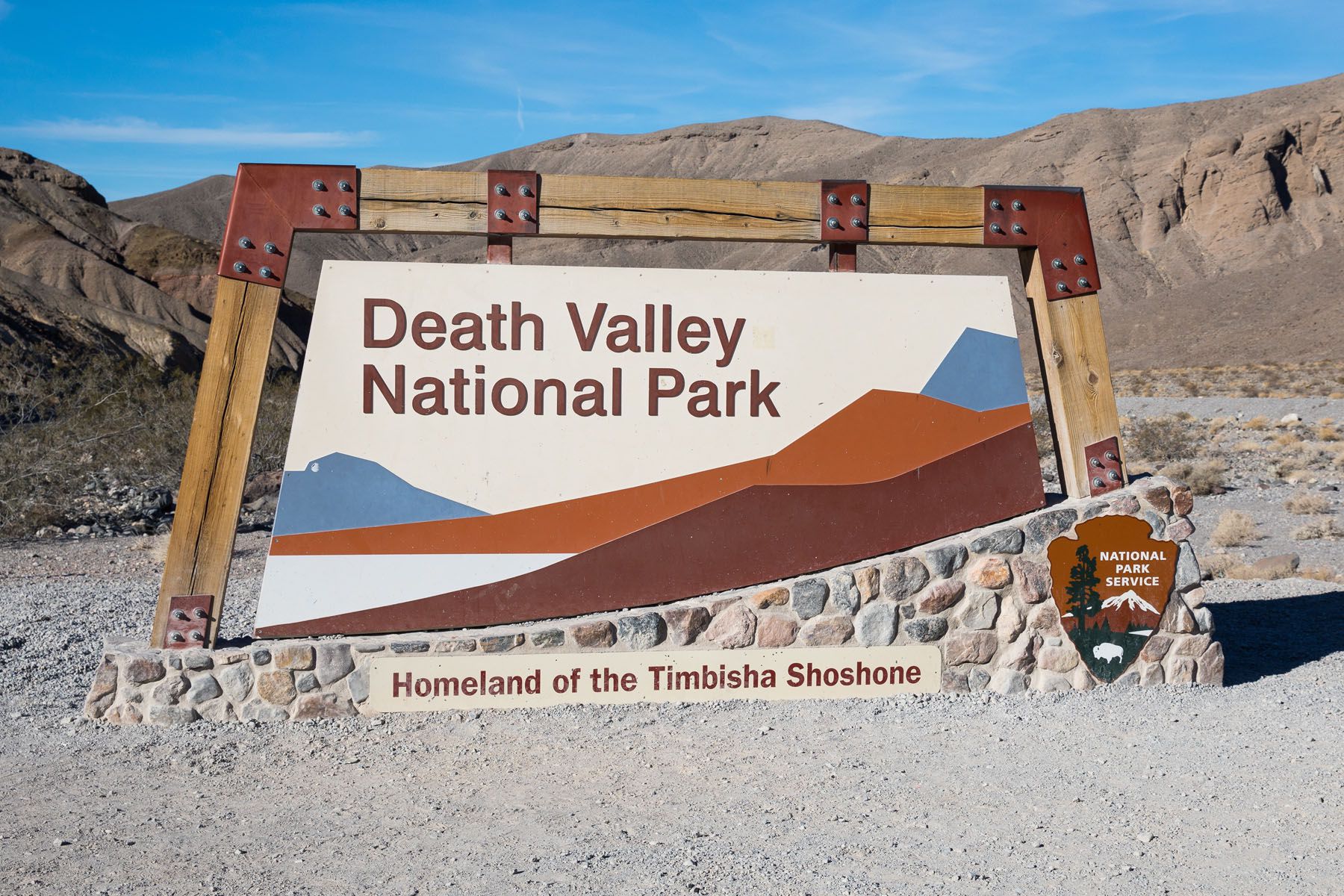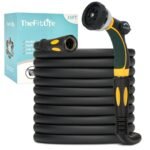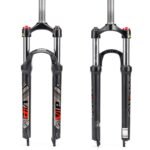Death Valley National Park, located on the border of California and Nevada, is a unique and fascinating destination for visitors from around the world. This national park is the largest national park in the lower 48 states and is known for its extreme temperatures, stunning landscapes, and diverse wildlife.
Find Your Next Adventure with Our National Parks Guide
Death Valley is a land of contrasts, with towering peaks covered in winter snow, vast fields of wildflowers after rare rainstorms, and a below-sea-level basin that experiences steady drought and record summer heat. Despite the harsh conditions, the park is home to a surprising amount of wildlife, including bighorn sheep, coyotes, and rattlesnakes, as well as a variety of plants and animals that are found nowhere else in the world.
Whether you’re interested in exploring the park’s rich history, taking in the stunning natural beauty, or becoming a Junior Ranger and earning a badge, Death Valley National Park has something for everyone. So why not plan a visit to this incredible destination and experience the diversity of life that can be found in North America’s hottest and driest national park?
Getting There
If you’re planning a trip to Death Valley National Park, you’ll need to know how to get there. Here are some options for getting to the park:
By Car
Most visitors to Death Valley National Park explore the park by private vehicle. The main east-west road through the park is CA Highway 190, and the main north-south roads in the park are North Highway and Badwater Road (CA 178) 1.
If you’re coming from Las Vegas, take US-95 south to NV-373, which will take you to Death Valley Junction. From there, it’s about a 30-minute drive to Furnace Creek, the main visitor center in the park 2. If you’re coming from Los Angeles, take I-15 north to Baker, then head west on CA-127 to Death Valley Junction 3.
If you’re coming from the town of Pahrump, Nevada, take NV-372 east to CA-190, which will take you into the park 4. If you’re coming from the town of Shoshone, California, take CA-127 north to CA-178, which will take you into the park 1.
By Air
If you’re flying to Death Valley National Park, the closest airport is McCarran International Airport in Las Vegas, which is about a 2.5-hour drive from the park 2. Another option is to fly into Los Angeles International Airport, which is about a 4-hour drive from the park 3.
Once you arrive at the airport, you can rent a car and drive to the park. Alternatively, you can take a shuttle or taxi to the park, but keep in mind that there is no public transportation to or within the park 1.
No matter how you get to Death Valley National Park, be sure to check the weather and road conditions before you go, as they can change quickly and unexpectedly. And remember to bring plenty of water and sunscreen, as the park is known for its extreme heat and dry conditions 1.
Things to Do
Death Valley National Park is a hiker’s paradise with deep canyons, salt flats, sand dunes, and desert peaks. There are plenty of activities to do in the park, including hiking, camping, wildlife viewing, stargazing, scenic drives, and visiting museums and visitor centers.
Hiking
With over 800 miles of trails, Death Valley National Park offers hiking opportunities for all skill levels. From the challenging Telescope Peak to the scenic Artists Drive, there is something for everyone. Some of the most popular hikes include:
- Telescope Peak: This challenging hike takes you to the highest point in Death Valley National Park. The 14-mile round trip hike is not for the faint of heart but offers stunning views of the surrounding area.
- Artists Drive: This scenic drive offers breathtaking views of the colorful rock formations in the park. There are several pullouts where you can stop and take pictures.
- Mesquite Flat Sand Dunes: These sand dunes are the most accessible in the park and are a popular spot for sunrise and sunset photography.
Camping
Death Valley National Park has a variety of campgrounds, from primitive to full hook-up. Some of the most popular campgrounds include:
- Furnace Creek Campground: This campground is the largest in the park and offers full hook-up sites as well as tent camping. It is located near the Furnace Creek Visitor Center and is a great base camp for exploring the park.
- Panamint Springs Campground: This campground is located on the western edge of the park and offers stunning views of the surrounding mountains.
- Stovepipe Wells Campground: This campground is located near the Mesquite Flat Sand Dunes and offers tent and RV camping.
Wildlife Viewing
Death Valley National Park is home to a variety of wildlife, including bighorn sheep, coyotes, and kit foxes. Some of the best places to view wildlife in the park include:
- Salt Creek: This creek is home to the endangered pupfish and is a popular spot for bird watching.
- Badwater Basin: This salt flat is the lowest point in North America and is home to a variety of unique plant and animal life.
- Badlands: This area is home to a variety of desert animals, including bighorn sheep, coyotes, and kit foxes.
Stargazing
Death Valley National Park is one of the best places in the world for stargazing. The park is a designated Dark Sky Park and offers some of the clearest skies in the country. Some of the best places to stargaze in the park include:
- Zabriskie Point: This scenic overlook offers stunning views of the night sky.
- Ubehebe Crater: This volcanic crater offers a unique stargazing experience.
- Dark Sky Campground: This campground is located in a remote area of the park and offers some of the best stargazing in the park.
Scenic Drives
Death Valley National Park offers some of the most scenic drives in the country. Some of the most popular scenic drives include:
- Artists Drive: This scenic drive offers breathtaking views of the colorful rock formations in the park.
- Golden Canyon: This canyon offers stunning views of the surrounding mountains and is a popular spot for hiking and photography.
- Mosaic Canyon: This canyon offers a unique hiking experience with its polished marble walls.
Museums and Visitor Centers
Death Valley National Park has several museums and visitor centers that offer information about the park’s history and geology. Some of the most popular museums and visitor centers include:
- Furnace Creek Visitor Center: This visitor center offers information about the park’s history and geology as well as exhibits on the park’s wildlife and plant life.
- Borax Museum: This museum offers information about the mining history of Death Valley National Park.
- Inn at Death Valley: This historic hotel offers exhibits on the park’s history and geology as well as a gift shop and restaurant.
Park Information
If you’re planning a trip to Death Valley National Park, it’s important to know some basic information about the park. Here are some key topics to keep in mind:
Weather and Climate
Death Valley National Park is known for its extreme weather and climate. The park is located in a below-sea-level basin, which means it’s one of the hottest and driest places on Earth. In the summer, temperatures can soar to over 120°F (49°C), so it’s important to take precautions if you’re visiting during this time. However, in the winter, temperatures can drop below freezing and even snow can fall on the towering peaks.
Park History
Death Valley National Park has a rich history that dates back thousands of years. The area was home to several Native American tribes, including the Timbisha Shoshone, who still have a presence in the park today. In the 1800s, the area was explored by European settlers, and mining became a major industry. Today, the park is managed by the National Park Service and is a popular destination for tourists from around the world.
Park Geology
Death Valley National Park is known for its unique geology. The park is located in the Mojave Desert, which is one of the most geologically active regions in the world. The park is home to several geological features, including the lowest point in North America (Badwater Basin), the highest point in the park (Telescope Peak), and the famous Racetrack Playa, where rocks mysteriously move across the desert floor.
Park Flora and Fauna
Despite its harsh environment, Death Valley National Park is home to a surprising variety of plant and animal life. The park is home to over 1,000 plant species, including several rare and endemic species. The park is also home to several species of wildlife, including coyotes, bobcats, bighorn sheep, and several species of birds.
Park Regulations
When visiting Death Valley National Park, it’s important to follow the park regulations to ensure your safety and the safety of others. Some important rules to keep in mind include staying on designated trails, not feeding the wildlife, and not collecting any natural or cultural resources. Pets are allowed in the park but must be kept on a leash at all times.
Overall, Death Valley National Park is a fascinating and unique destination that is worth a visit. Be sure to download the NPS app before your visit to stay up-to-date on park information and speak to the park superintendent if you have any questions or concerns.
Nearby Attractions
If you’re visiting Death Valley National Park, there are plenty of nearby attractions to explore. From historic sites to natural wonders, there’s something for everyone.
Borax Museum
The Borax Museum at Furnace Creek is a must-see attraction for history buffs. The museum features exhibits on the mining and processing of borax, which was a major industry in Death Valley in the late 1800s and early 1900s. Visitors can learn about the famous “20 Mule Team” that transported borax from Death Valley to the railroad in the early days of the industry.
Charcoal Kilns
The Charcoal Kilns are a set of ten beehive-shaped structures that were used to produce charcoal for the Modock Consolidated Mining Company in the late 1800s. The kilns are located in Wildrose Canyon, about 25 miles from the park’s western border. They are a popular spot for photographers and history enthusiasts.
Ghost Towns
There are several ghost towns in the area surrounding Death Valley National Park, including Rhyolite, Skidoo, and Ballarat. These towns were once bustling mining communities, but today they are abandoned and offer a glimpse into the region’s past.
Ubehebe Crater
Ubehebe Crater is a large volcanic crater located in the northern part of the park. The crater is about half a mile wide and 500 feet deep, and was formed by a steam explosion about 2,000 years ago. Visitors can hike around the rim of the crater and take in the stunning views.
Saline Valley Hot Springs
The Saline Valley Hot Springs are a set of natural hot springs located in the remote Saline Valley, about 50 miles from the park’s western border. The hot springs are a popular spot for soaking and relaxing, and are accessible via a rough dirt road.
Eureka Dunes
The Eureka Dunes are a set of large sand dunes located in the northern part of the park. The dunes are some of the tallest in North America, with the highest dune reaching over 700 feet. Visitors can hike to the top of the dunes for stunning views of the surrounding desert.
Joshua Tree National Park
While not technically a nearby attraction, Joshua Tree National Park is located just a few hours’ drive from Death Valley and is well worth a visit. The park is known for its unique rock formations and its namesake Joshua trees, which are a type of yucca plant. Visitors can hike, rock climb, and stargaze in the park’s stunning desert landscape.
Whether you’re interested in history, geology, or just exploring the great outdoors, there’s no shortage of nearby attractions to discover during your visit to Death Valley National Park.
Frequently Asked Questions
Why is Death Valley so dangerous?
Death Valley is considered dangerous because of its extreme heat, lack of water, and rugged terrain. The park has recorded the highest temperature in the world, which was 134 degrees Fahrenheit (56.7 degrees Celsius) in 1913. Visitors are advised to carry plenty of water and avoid hiking during the hottest parts of the day.
What are some things to do in Death Valley?
Death Valley National Park offers a variety of activities for visitors. Some popular activities include hiking, camping, stargazing, and scenic drives. The park is also home to unique geological formations, such as the Mesquite Flat Sand Dunes and the Badwater Basin.
How big is Death Valley National Park?
Death Valley National Park is one of the largest national parks in the United States, covering approximately 3.4 million acres. The park spans across California and Nevada.
How was Death Valley formed?
Death Valley was formed by a combination of geological processes, including faulting, erosion, and volcanic activity. The valley was once a large lake, but over time it dried up, leaving behind a salt flat and other unique geological features.
Is Death Valley in California or Nevada?
Death Valley is located in both California and Nevada. The majority of the park is in California, but a small portion of it extends into Nevada.
How much of Death Valley National Park is in Nevada?
Approximately 91,000 acres of Death Valley National Park are located in Nevada. This area is home to unique geological formations, such as the Titus Canyon and the Grapevine Mountains.
Footnotes

Meet Kevin Goodell, your outdoor adventure coach! With a passion for nature ignited in childhood, Kevin brings a wealth of experience and expertise to simplify tough outdoor skills. As a U.S. Army veteran and former Sergeant, he has honed his leadership and teamwork abilities while developing a deep love for the great outdoors.
Kevin’s dedication to outdoor activities spans biking, birdwatching, national park trips, and archery/golf. With his friendly and approachable demeanor, he is committed to guiding individuals of all ages and skill levels towards unforgettable outdoor experiences.
Harnessing his extensive knowledge and personal achievements, Kevin is your go-to resource for learning and enjoying various outdoor pursuits. Whether you seek thrilling adventures or serene nature escapes, Kevin’s professional yet friendly approach will ensure an engaging and informative experience. Embark on your next outdoor adventure with Kevin Goodell and embrace the beauty of nature like never before.






